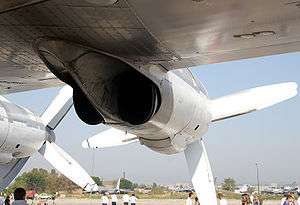Kuznetsov NK-12
The Kuznetsov NK-12 is a Soviet turboprop engine of the 1950s, designed by the Kuznetsov design bureau. The NK-12 drives two large four-bladed contra-rotating propellers, 5.6 m (18 ft) diameter (NK-12MA), and 6.2 m (20 ft) diameter (NK-12MV). It is the most powerful turboprop engine to enter service.
| NK-12 | |
|---|---|
 | |
| NK-12M Turboprop engine on a Tu-95 at RIAT Fairford 1993 | |
| Type | Turboprop |
| National origin | Soviet Union |
| Manufacturer | Kuznetsov Design Bureau |
| Major applications | Antonov An-22 Tupolev Tu-95 Tupolev Tu-114 |

.jpg)
Design and development
The design that eventually became the NK-12 turboprop was developed after World War II by a team of Russian scientists and deported German engineers under Ferdinand Brandner, who had worked for Junkers previously; the design bureau was headed by chief engineer Nikolai D. Kuznetsov. Thus, the NK-12 design evolved from late-war German turboprop studies. This started with the postwar development of the wartime Jumo 022 turboprop design that was designed to develop 6,000 shp (4,500 kW), weighing 3,000 kg (6,600 lb). The effort continued with a 5,000 shp (3,700 kW), weighing 1,700 kg (3,700 lb), completed by 1947. Evolution to the TV-12 12,000 shp (8,900 kW) engine required extensive use of new Soviet-developed alloys and was completed in 1951.
The NK-12 remains the most powerful turboprop engine to enter service, although the Europrop TP400 (in 2005) has come close to this. Another engine of similar size, the Pratt & Whitney T57 with 15,000 shp (11,000 kW) and 5,000 lbf (22 kN) jet thrust, ran 3,100 hours before being cancelled in 1957.[1][2] The NK-12 powers the Tupolev Tu-95 bomber and its derivatives such as the Tu-142 maritime patrol aircraft and the Tupolev Tu-114 airliner (with NK-12MV), which still holds the title of the world's fastest propeller-driven aircraft despite being retired from service in 1991. It also powered the Antonov An-22 Antei (with NK-12MA), the world's largest aircraft at the time, and several types of amphibious assault craft, such as the A-90 Orlyonok "Ekranoplan".
The engine has a 14-stage axial-flow compressor, producing pressure ratios between 9:1 and 13:1 depending on altitude, with variable inlet guide vanes and blow-off valves for engine operability. The combustion system used is a cannular-type: each flame tube is centrally mounted on a downstream injector that ends in an annular secondary region. The contra-rotating propellers and compressor are driven by the five-stage axial turbine. Mass flow is 65 kg (143 lb) per second.[3]
Variants
Data from Alexandrov
- NK-12
- 12,500 hp (9,300 kW), initial development model, used on the Tupolev Tu-95 and Tupolev Tu-116
- NK-12M
- 12,000 hp (8,950 kW), used on the Tupolev Tu-114
- NK-12MV
- 14,795 hp (11,033 kW),[4] 5.6 m diameter (18 ft 4 in; 560 cm; 220 in) AV-60 propellers, used on the Tupolev Tu-95, Tupolev Tu-126, and Tupolev Tu-142
- NK-12MA
- 15,001 hp (11,186 kW), 6.2 m diameter (20 ft 4 in; 620 cm; 244 in) AV-90 propellers, used on the Antonov An-22
- NK-12MK
- 14,795 hp (11,033 kW), 5.6 m diameter (18 ft 4 in; 560 cm; 220 in) propellers, built with corrosion-resistant materials, used on the A-90 Orlyonok
- NK-12MP
- 14,795 hp (11,033 kW),[5], modernized version used on the Tupolev Tu-95MS and Tupolev Tu-142M
Applications
Specifications (NK-12MV)
Data from Aircraft engines of the World 1970[6], Civil Turboshaft/Turboprop Specifications[7]
General characteristics
- Type: Turboprop engine
- Length: 6 m (20 ft)
- Diameter: 1,150 mm (45 in)
- Dry weight: 2,900 kg (6,400 lb)
Components
- Compressor: 14-stage axial flow
- Combustors: 12 combustion chambers
- Turbine: 5-stage axial turbine
- Fuel type: Aviation kerosene such as JP-4 / Soviet spec. T-1 or T-2
- Oil system: Pressure spray at 5.9 bar (85 psi)
Performance
- Maximum power output: 11,000 kW (15,000 shp) (equivalent) / 11,000 kW (14,750 shp) + 2.78 kN (625 lbf) at 9,250 rpm
- Overall pressure ratio: 13:1 at 9,250 rpm
- Air mass flow: 65 kg/s (140 lb/s) at 9,250 rpm
- Turbine inlet temperature: 1,250 K (980 °C)
- Specific fuel consumption: 0.219 kg/kW/h (0.360 lb/shp/h)
- Power-to-weight ratio: 3.7 kW/kg (2.3 hp/lb)
References
- Connors, J. (2010). The engines of Pratt & Whitney : a technical history. American Institute of Aeronautics and Astronautics. p. 294. ISBN 978-1-60086-711-8.
- Mulready, Dick (2001). Advanced engine development at Pratt & Whitney : the inside story of eight special projects, 1946-1971. Society of Automotive Engineers. p. 20. ISBN 9780768006643.
- "Creation of the TV-2 (NK-12) turboprop engine". www.airpages.ru. Retrieved 22 March 2019.
- "NK-12MV" (PDF). Ulyanovsk Higher Aviation School of Civil Aviation. Domestic Aerospace Engineering (in Russian). p. 18. Retrieved August 21, 2019.
- "NK-12MP, NK-12MK" (PDF). Ulyanovsk Higher Aviation School of Civil Aviation. Domestic Aerospace Engineering (in Russian). p. 19. Retrieved August 21, 2019.
- Wilkinson, Paul H. (1970). Aircraft engines of the World 1970 (22nd ed.). London: Paul H. Wilkinson. p. 221.
- Civil Turboshaft/Turboprop Specifications
External links
| Wikimedia Commons has media related to Kuznetsov NK-12. |
- ciad.ssau.ru - Image
- airventure.de - Image, finnish museum
- "Propfans: Thrust class > 10000 kgf: Technical characteristics". Aerosila. Archived from the original on October 15, 2017.